Enquanto tentava (e falhei) convencer meu filho a comer o jantar, tentei cantar para ele. No meio dessa música, eu percebi que a estrutura da fórmula poderia se dar bem no código do golfe!
A tarefa é escrever um programa ou função que não aceita entrada e produz o seguinte texto:
There's a hole in the bottom of the sea
There's a hole in the bottom of the sea
There's a hole, there's a hole
There's a hole in the bottom of the sea
There's a log in the hole in the bottom of the sea
There's a log in the hole in the bottom of the sea
There's a hole, there's a hole
There's a hole in the bottom of the sea
There's a bump on the log in the hole in the bottom of the sea
There's a bump on the log in the hole in the bottom of the sea
There's a hole, there's a hole
There's a hole in the bottom of the sea
There's a frog on the bump on the log in the hole in the bottom of the sea
There's a frog on the bump on the log in the hole in the bottom of the sea
There's a hole, there's a hole
There's a hole in the bottom of the sea
There's a wart on the frog on the bump on the log in the hole in the bottom of the sea
There's a wart on the frog on the bump on the log in the hole in the bottom of the sea
There's a hole, there's a hole
There's a hole in the bottom of the sea
There's a hair on the wart on the frog on the bump on the log in the hole in the bottom of the sea
There's a hair on the wart on the frog on the bump on the log in the hole in the bottom of the sea
There's a hole, there's a hole
There's a hole in the bottom of the sea
There's a fly on the hair on the wart on the frog on the bump on the log in the hole in the bottom of the sea
There's a fly on the hair on the wart on the frog on the bump on the log in the hole in the bottom of the sea
There's a hole, there's a hole
There's a hole in the bottom of the sea
There's a flea on the fly on the hair on the wart on the frog on the bump on the log in the hole in the bottom of the sea
There's a flea on the fly on the hair on the wart on the frog on the bump on the log in the hole in the bottom of the sea
There's a hole, there's a hole
There's a hole in the bottom of the sea
There's a smile on the flea on the fly on the hair on the wart on the frog on the bump on the log in the hole in the bottom of the sea
There's a smile on the flea on the fly on the hair on the wart on the frog on the bump on the log in the hole in the bottom of the sea
There's a hole, there's a hole
There's a hole in the bottom of the sea
Regras do desafio:
- O texto pode ser impresso ou retornado como saída de função
- Cada verso é separado por uma única linha vazia
- O espaço em branco à direita é aceitável, desde que não mude o layout (portanto, não há espaço em branco à esquerda nem espaços extras entre as palavras)
- As novas linhas à direita também são boas.
- Não há novas linhas principais.
- Todos os idiomas são bem-vindos, e isso é código-golfe ; portanto, a resposta mais curta em bytes para cada idioma vence!
gzip -5compacta em 186 bytes ( bzip2e xzparece piorar).
